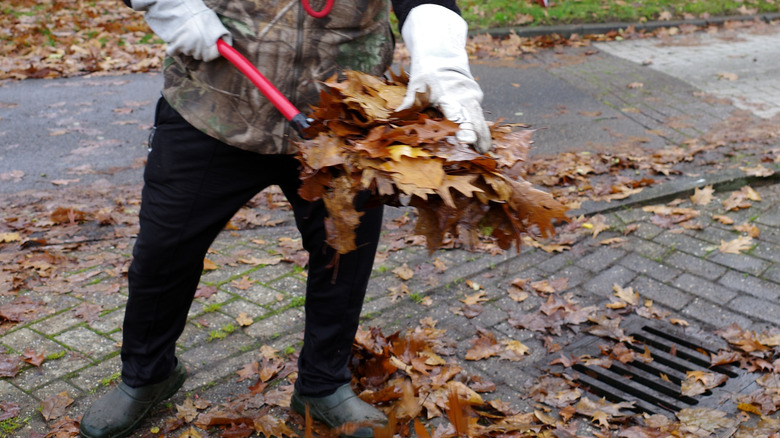Why Boiling Water Is Your Secret Weapon When Fall Leaves Start To Accumulate In Your Drains
For most homeowners, blocked drains inside the house can be a common annoyance, leading to backed-up sinks, unpleasant odors, and water damage. Many find it essential to learn how to clean a kitchen sink drain as a DIY job, but if it's beyond your scope, you'll likely have to call a plumber to take care of the problem – and potentially pay a big bill in the process. Blockages are a serious problem, but these issues and the damage they cause are hardly limited to the drains in the home's plumbing. Don't become so focused on indoor clogs that you forget to check the drains you have outside your house. You might have stormwater drainage solutions around your home, such as French drains, storm grates, trenches, and catch basins. When these items have clogs, you risk standing water, eroded landscaping, and damage to the home's foundation. Fallen leaves in autumn, twigs, and other debris can build up over the top of and inside these drainage systems, leading to slowed water movement and backups. If you have clogs in these areas, one of the fastest potential fixes is boiling water.
Carefully pouring boiling water into the area with the clogged leaves helps to soften or loosen the materials causing the leaves to stick before washing them away. This method is safe for most outdoor pipes, but if you have PVC plastic, the heat could gradually cause them to melt. Polyethylene plastic (corrugated plastic outdoor drains typically consist of HDPE), polypropylene plastic, ABS (acrylonitrile butadiene styrene), and metal pipes are generally resistant to damage from boiling water. When you need a little extra cleaning power, you can also pair (or replace) boiling water with other convenient solutions.
When boiling water is especially effective on leaf clogs
One area where the boiling water treatment method can be effective is a leaf-plugged drain around a vertical cleanout. While you should always know how to locate a sewer cleanout pipe in an emergency, it's equally important to know what to do when you find it, as it extends above the ground and provides easy access to the home's sewage system. The vertical cleanout pipe is supposed to have a cap, but if someone doesn't replace the cap properly or it suffers damage or wear, leaves could find their way in and create a clog. Such cleanout pipes may have grease, fat, and similar types of household waste inside them, causing the leaves to stick. The boiling water can help melt the fat and grease, allowing the leaves to wash away.
Boiling water will also slowly wash away clogs in outdoor drains that may be plugged with mud and stuck leaves. Before pouring boiling water into your outdoor drains that are packed with leaves, start by clearing the drain's surface and interior of debris to give it a clear path to the clog. Rake the debris away from the entrance to the drain, or use a leaf blower to clear the space to allow water to flow freely. You could also remove the cover to the outdoor drain and reach inside to pull out any debris getting in the way. If you have a shop vacuum, you can use it to suck out the excess leaves and twigs close to the opening.
Other options to clear stuck leaves in outdoor drains
Pouring boiling water down the outdoor drain plugged with leaves is a fast option to clear the clog using natural materials. Some people swear by using a cup of baking soda and a cup of vinegar mixed inside the drain after adding the boiling water and repeating the process every two hours. These are common household items, though you should still apply them with care, as they could gradually degrade the pipes if used too often.
If boiling water doesn't work and you need to use a more invasive option to clear the leaves, use a pressure hose to try to wash the leaves farther into the drain. If you own a drain snake, you can use it to reach leaves that are deeper in the outdoor drain pipe and causing a clog (power augers are also available to rent at many home improvement stores). The snake should be able to grab clumps of leaves and pull them out. After removing the larger clumps, try the boiling water method again to eliminate any remaining leaves. When using more invasive options, always wear eye goggles, gloves, boots, and a mask to protect yourself from potentially harmful materials splashing or flying out of the drain.
To prevent future clogs, remove any new leaves that appear near the drain and consider adding new filters and replacing worn parts. You should place any leaves and debris in a bag for pickup or haul them to a compost area. You don't want them to wash back over the top of the drain again the next time it rains. Remove leaves before they have a chance to break down, keeping the smaller pieces from easily entering the drain.


